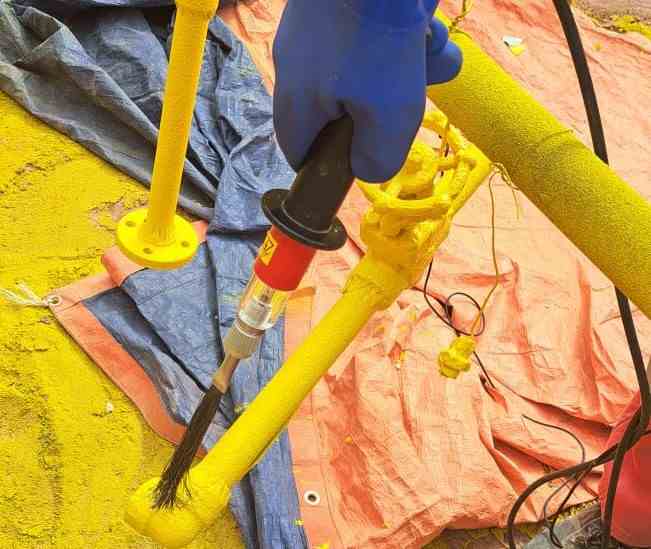Industrial paint coatings protect metal surfaces from rust, wear, and contamination in tough environments like factories, pipelines, or power plants. However, tiny flaws in these coatings, such as cracks, holes, or thin spots, can cause big problems by letting moisture or chemicals reach the metal. These flaws, called discontinuities or “holidays,” are often too small to see with the naked eye. Fortunately, holiday testing, as described in ASTM D5162-01, uses electrical methods to find these issues and ensure the coating does its job. In this article, we’ll explain holiday testing in simple terms, covering why it matters, how it works, and what to watch out for, with plenty of transition words to guide you through.
What is Holiday Testing?
To begin with, holiday testing is a way to check for tiny defects in nonconductive paint coatings applied to metal surfaces. These coatings, which don’t conduct electricity, are tested using a device called a holiday detector. Essentially, the detector sends an electric current across the coating to find spots where the current can pass through to the metal, revealing a flaw. According to ASTM D5162, a discontinuity is any crack, void, thin spot, or contamination that weakens the coating’s ability to block electricity. These flaws are also called holidays or pinholes, with pinholes being tiny, hole-like defects that might go all the way through the coating.
Moreover, the ASTM D5162 standard describes two main ways to do holiday testing: Low Voltage Wet Sponge Testing and High Voltage Spark Testing. Each method is best for different coating thicknesses, and we’ll explore both in detail later.
Spark of Safety: High Voltage Holiday Testing for Festive Paint Coatings
Why Holiday Testing Matters

Next, let’s talk about why holiday testing is so important. Industrial paint coatings are applied to metal to prevent rust, reduce wear, or keep products clean in industries like oil and gas or manufacturing. For example, a pipeline’s coating might need to be perfect to withstand harsh chemicals, while a factory machine might tolerate a few minor flaws. By detecting holidays, testing ensures the coating will last and protect the metal as intended.
Additionally, holiday testing offers several key benefits:
- Quality Check: It confirms that a new coating is free of defects before it’s put into use.
- Cost Savings: Finding and fixing flaws early prevents expensive repairs or replacements later.
- Safety and Standards: It helps meet industry rules and keeps equipment safe for workers.
However, ASTM D5162 warns that holiday testing works best on fresh coatings. If a coating has already been exposed to water or chemicals, testing might damage it or give false results, so extra care is needed.
How Holiday Testing Works: Two Methods
Now, let’s dive into the two testing methods outlined in ASTM D5162. Each uses different equipment and is suited for specific coating thicknesses.
Test Method A: Low Voltage Wet Sponge Testing
First, the low voltage wet sponge method is perfect for thinner coatings, up to 20 mils (0.5 mm) thick. This method uses a small, battery-powered device that applies a low voltage (5–90 volts) through a wet sponge. When the sponge touches a flaw, the device beeps or flashes to show a discontinuity.
Here’s how it works, step by step:
- Get Ready: Make sure the coating is fully dry, as wet paint can cause false results. Check with the paint manufacturer for drying times. Also, clean the surface to remove dirt or oil.
- Set Up the Device: Connect a ground wire to the metal surface. Then, wet the sponge with water mixed with a tiny amount of a special soap (like one used for developing photos). Don’t use salt in the water—it can mess up the test or make future paint layers peel.
- Test the Coating: Move the sponge over the coating slowly, about 1 foot per second, pressing gently to keep the surface wet. Go over each spot twice. If the device signals a flaw, use the sponge’s tip to find the exact spot.
- Mark Flaws: Use a marker that won’t harm the coating to mark spots that need fixing.
- Check the Device: Every so often, touch the sponge to bare metal to ensure the device is working properly.
For instance, the equipment is lightweight and easy to carry, with two types of devices: one you can adjust in the field and another that’s preset. Importantly, this method is gentle and won’t harm thin coatings, but it’s not suitable for thicker ones.
Test Method B: High Voltage Spark Testing
On the other hand, the high voltage spark testing method is designed for coatings thicker than 20 mils (0.5 mm). This method uses a device that sends high-voltage sparks (up to 25,000 volts) to find flaws. Because it’s more powerful, it requires extra caution.
Here’s the basic process:
- Prepare the Coating: Ensure the coating is fully dry and the surface is clean.
- Choose the Voltage: Pick a voltage based on the coating’s thickness, using a table from ASTM D5162 (see below for examples). For instance, a 19–30 mil coating needs about 2,500 volts.
- Test the Coating: Follow the device’s instructions to move the tester over the coating, watching for sparks that indicate flaws.
- Mark Flaws: Use a safe marker to note areas for repair.
However, this method has risks. For example, using high voltage on a thin coating can damage it, so always check with the paint manufacturer. Also, the air’s humidity or temperature can affect the test, so you may need to adjust the voltage.
Things to Keep in Mind
Before testing, there are several important points to consider to get accurate results and avoid problems:
- Check with the Paint Maker: Ask how long the coating needs to dry and whether it contains materials that conduct electricity, which could affect the test.
- Measure Coating Thickness: Use a tool to check the coating’s thickness to decide which method to use—low voltage for thin coatings, high voltage for thick ones.
- Set Flaw Limits: Decide how many flaws are okay based on the coating’s purpose and thickness. Some projects need zero defects, while others allow a few.
- Stay Safe: High voltage testing can be dangerous, so follow safety rules and wear protective gear. Even low voltage testing requires care to avoid mistakes.
- Keep the Surface Clean: Dirt or oil can cause false results, so clean the coating thoroughly before testing.
- Avoid Old Coatings: Testing coatings that have been exposed to water or chemicals can damage them or give wrong results. Stick to new coatings whenever possible.
Suggested Voltages for High Voltage Testing
To help choose the right voltage for high voltage spark testing, ASTM D5162 provides a handy table. Here are some examples:
- 8–12 mils (0.20–0.31 mm): 1,500 volts
- 19–30 mils (0.47–0.77 mm): 2,500 volts
- 41–60 mils (1.04–1.54 mm): 5,000 volts
- 81–100 mils (2.05–2.55 mm): 10,000 volts
- 161–200 mils (4.08–5.09 mm): 20,000 volts
In addition, these are starting points. You might need to tweak the voltage based on weather conditions or the coating’s properties.
Wrapping Up
In conclusion, holiday testing is a vital step to ensure industrial paint coatings protect metal surfaces effectively. By finding tiny flaws that could lead to rust or failure, it saves money and keeps equipment safe. Whether using the gentle low voltage wet sponge method for thin coatings or the powerful high voltage spark method for thicker ones, following ASTM D5162’s guidelines ensures reliable results. However, always check with the paint manufacturer, use the right equipment, and take safety seriously. With careful testing, industries can trust their coatings to stand up to tough conditions, keeping their operations running smoothly.
FAQs on Holiday Testing for Industrial Paint Coatings
1. What is holiday testing, and why is it important for industrial paint coatings?
Answer: Holiday testing is a method to find tiny flaws, like cracks or holes (called discontinuities or holidays), in nonconductive paint coatings on metal surfaces. These flaws can let moisture or chemicals reach the metal, causing rust or damage. Using electrical devices, holiday testing checks if the coating is solid and protective. It’s important because it ensures the coating works properly, prevents costly repairs, and keeps equipment safe in industries like oil and gas or manufacturing. According to ASTM D5162, testing is best for new coatings to confirm quality before use.
2. What are the two methods of holiday testing, and when should each be used?
Answer: ASTM D5162 describes two methods: Low Voltage Wet Sponge Testing and High Voltage Spark Testing. The low voltage method uses a wet sponge and low electricity (5–90 volts) to find flaws in thin coatings (up to 20 mils or 0.5 mm thick). It’s gentle and safe for delicate coatings. The high voltage method uses stronger electricity (up to 25,000 volts) for thicker coatings (over 20 mils). It’s more powerful but can damage thin coatings, so check with the paint manufacturer. Choose the method based on the coating’s thickness, measured with a thickness gauge, to get accurate results without harm.

